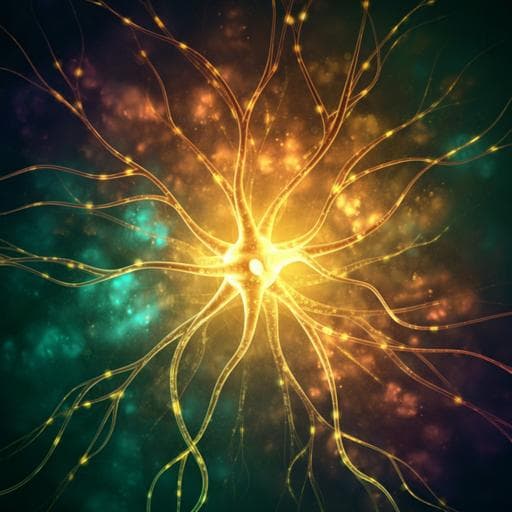
Psychology
Repeated exposure with short-term behavioral stress resolves pre-existing stress-induced depressive-like behavior in mice
E. Lee, J. Park, et al.
Discover how chronic stress and glucocorticoids interact in surprising ways to alleviate stress-induced depressive-like behavior in mice. Research by Eun-Hwa Lee and colleagues reveals that a simple five-minute stress resolution technique can reverse mood disorders, illuminating complex neural pathways. Dive into the science behind this innovative approach!
~3 min • Beginner • English
Introduction
The study addresses whether brief, repeated bouts of behavioral stress can modify (rather than strengthen) maladaptive stress gains produced by chronic stress and thereby reverse depressive-like behavior. Background: Stress activates the HPA axis, elevating glucocorticoids (GCs) that normally support adaptive physiology, yet chronic stress induces lasting genomic, structural, and functional changes in limbic circuits, including the medial prefrontal cortex (mPFC), leading to depressive phenotypes and HPA dysregulation. Although chronic GC exposure is linked to depression, paradoxical reports show GR agonists can acutely produce antidepressant effects. The authors hypothesize that implementing short-term stress may place preexisting stress gains into a transiently labile state, allowing their modification. They further propose that daily brief restraint or low-dose GC could remediate maladaptive stress responses, particularly within the prelimbic cortex (PL), thereby correcting depressive-like behavior and HPA axis dysregulation.
Literature Review
Prior work shows chronic stress reduces glutamate transmission, neuronal activity, and dendritic structure in mPFC, leading to persistent depressive-like behavior and HPA axis dysregulation. Conversely, GR agonists (e.g., dexamethasone, cortisol) can acutely improve depressive symptoms in humans, and low-dose corticosterone reduces immobility in mice. Chronic GC administration at higher doses can induce depressive-like behavior and HPA dysfunction in rodents, reinforcing GC’s role as a mediator of chronic stress. The PL and broader mPFC coordinate neuroendocrine and affective responses; GABAergic dysfunction and glutamate receptor changes are implicated in stress-induced depression. Behavioral therapies (cognitive reappraisal, CBT, exposure therapy) benefit PTSD and depression, but whether eliciting stress responses is mechanistically necessary for therapeutic effects remains unclear. These lines of evidence motivate testing whether controlled short-term stress can modify maladaptive gains rather than reinforce them.
Methodology
Animals: Male C57BL/6 mice (primary experiments) and outbred ICR mice (maternal stress cohort). Housing under standard conditions; experiments approved by IACUC.
Stress paradigms: Chronic restraint stress (CRST): 2 h/day restraint for 14 days. Short-term restraint: 5, 10, or 15 min per day (RS5, RS10, RS15) for up to 14 days, typically administered after CRST. Chronic social defeat stress (CSDS): 10-day protocol with physical defeat and sensory exposure; mice classified as susceptible or resilient by social interaction ratio.
Behavioral tests: Two-chamber sociability test (SIT), sucrose preference test (SPT), tail suspension test (TST), and forced swim test (FST). PCA and K-means clustering integrated multiple behavioral and physiological readouts.
Hormone assays and HPA assessment: Serum corticosterone (CORT) measured by ELISA at baseline and following single 5-min restraint (S5). Basal adrenal gland weight measured. Expression of CRH and AVP in PVN quantified by qPCR. Pharmacological manipulations: Low-dose CORT injections (0.1, 0.5, 1.0 mg/kg i.p., repeated), imipramine (20 mg/kg), CRHR1 antagonist (NBI27914), GR antagonist (RU486). Adrenalectomy (ADX) vs sham surgery to ablate adrenal function.
Neural activity mapping: c-Fos immunohistochemistry after single or repeated 5- or 15-min restraint, and after low-dose CORT. Regions quantified included PL, IL, BLA, NAcc, DG, vSub, BNST (dorsal/ventral), PVN.
Molecular analyses: Microarray of PL tissue after CRST and after RS5; GO enrichment and PPI (STRING) with serial K-means clustering; validation by qPCR for stress/GC-related genes (Nr3c1/GR, Nr3c2/MR, Fkbp5, Fkbp4, Hsp90aa1, Hsp90ab1, Dusp1, CaMKIIα, ERK1/2). Immunofluorescence for GR, Fkbp5; nuclear localization assessed. Western blots for p-CaMKIIα, CaMKIIα, p-ERK1/2, ERK1/2.
Genetic and pharmacologic perturbations in PL: siRNA knockdown in PL of GR, CaMKIIα, ERK1, ERK2; local PL infusions of picrotoxin (GABA_A antagonist) and KN-62 (CaMKII inhibitor) via cannula.
Circuit-level manipulations: DREADDs—AAV8-CaMKIIα-hM3D(Gq) or AAV8-CaMKIIα-hM4D(Gi) in PL neurons; projection-specific hM4D(Gi)/hM3D(Gq) in PL→dBNST, PL→BLA, PL→NAcc using retrograde WGA-Cre; CNO administered during RS5 to inhibit or stimulate targeted neurons/circuits. Optogenetics: AAV2/1-CaMKIIα-eNpHR-eYFP in PL with optic fiber in NAcc to inhibit PL→NAcc during behavior. c-Fos mapping verified circuit engagement. Controls included CNO-alone treatment.
Statistics: Mean ± SEM. Two-sided t-tests or one-way ANOVA with Newman–Keuls post hoc. PCA and K-means (k=2) used to classify multidimensional behavioral/physiological outcomes.
Key Findings
- Repeated daily 5-min restraint (RS5) after CRST reversed depressive-like behaviors (restored sociability and sucrose preference; reduced immobility in TST/FST) to control-like levels, comparable to imipramine. RS10 and RS15 did not rescue behavior. Effects of RS5 persisted for at least 1 month.
- RS5 also rescued depressive-like behaviors in CSDS-susceptible mice and in ICR mice subjected to prenatal maternal stress plus CRST, indicating generalizability beyond restraint context and genetic background.
- HPA axis: In normal mice, 5- or 15-min restraint induced lower peak CORT than 2 h but with similar clearance kinetics. In CRST mice, a single 5-min restraint produced a higher CORT peak (124.2 ng/ml vs 97.4 ng/ml in controls) and slower clearance; RS5 normalized both peak and clearance, as well as elevated basal CORT and adrenal hypertrophy. CRST increased PVN CRH and AVP transcripts; RS5 normalized these. RS10/RS15 partially reduced basal CORT and PVN CRH/AVP.
- Low-dose CORT injections (0.1–1.0 mg/kg daily) mimicked RS5: rescued SIT, SPT, TST, FST, normalized basal CORT, and reduced adrenal weight. Behavioral recovery covaried with adrenal normalization in PCA/K-means clustering.
- Necessity of HPA activation: Blocking CRHR1 (NBI27914) or GR (RU486) interfered with RS5’s normalization of basal CORT and abolished RS5’s behavioral benefits. ADX eliminated CORT release and abolished RS5’s behavioral rescue; ADX alone did not improve behavior. Thus, HPA activation is required for RS5 efficacy.
- Brain activation: Repeated 5-min restraint increased c-Fos in PL, IL, vSub, DG, BNST (d/v), PVN, and other limbic regions; several regions (PL, vSub, dBNST, PVN) showed stronger activation with RS5 than RS15. Low-dose CORT induced a largely overlapping c-Fos map.
- PL molecular remodeling: CRST altered 264 PL genes (≥1.2-fold), and RS5 reversed these changes; RS5 changed 722 genes that overlapped with CRST-responsive sets. GO/PPI analysis identified clusters linked to stress and glucocorticoid responses. CRST downregulated GR and upregulated Fkbp5 (and downregulated Fkbp4); RS5 or low-dose CORT restored these. CRST reduced ERK1/2 transcripts; CORT (not RS5) restored them. Immunostaining showed CRST decreased nuclear GR and increased Fkbp5; RS5/CORT reversed. GR knockdown in PL increased Fkbp5, elevated PVN CRH/AVP, and induced depressive-like behavior.
- Signaling: CRST increased p-CaMKIIα and decreased p-ERK1/2 in PL; RS5 normalized p-CaMKIIα but not p-ERK1/2. p-CaMKIIα and GR were mainly in glutamatergic PL neurons. RS5/CORT reversed CRST’s increase in p-CaMKIIα and decrease in GR; single-cell analysis showed altered GR–p-CaMKIIα relationship in CRST normalized by RS5/CORT. PL CaMKIIα knockdown restored GR levels and rescued behavior; ERK1/2 knockdown did not restore GR (ERK2 partially affected Fkbp5). KN-62 infusion or siRNA-CaMKIIα in PL of naive mice induced depressive-like behavior, supporting CaMKIIα’s role.
- GABAergic modulation: CRST reduced GABA_A receptor subunits (GABRA1, GABRB2) in PL; RS5/CORT restored. Picrotoxin infusion into PL after RS5 increased p-CaMKIIα and abolished RS5’s behavioral rescue, suggesting RS5 restores inhibitory control to normalize CaMKIIα signaling.
- Glutamate receptors: CRST reduced NMDA receptor subunits (NR1, NR2A, NR2B) in PL; RS5/CORT restored.
- Causality of PL activity: Activating PL glutamatergic neurons with hM3D(Gq) in CRST mice reduced depressive-like behaviors; inhibiting PL neurons with hM4D(Gi) during RS5 blocked RS5’s behavioral and basal CORT normalization effects. CNO alone had no effects.
- Circuit specificity: Inhibiting PL→dBNST during RS5 blocked both behavioral rescue and basal CORT normalization; stimulating PL→dBNST in CRST mice mimicked RS5’s behavioral rescue. Inhibiting PL→BLA or PL→NAcc during RS5 blocked behavioral rescue but did not affect basal CORT normalization. Optogenetic inhibition of PL→NAcc during testing reversed RS5’s behavioral benefits, corroborating DREADD results.
Discussion
The findings show that appropriately dosed, repeated short-term stress (5 min daily) can reverse depressive-like behaviors and normalize HPA axis dysregulation caused by chronic stress. This supports the hypothesis that new, brief stress inputs can render maladaptive stress gains labile and amenable to modification, rather than further consolidating them. Mechanistically, RS5 acts via GC-dependent processes that require an intact HPA axis. At the neural level, RS5 engages PL-centered networks and modulates molecular pathways (GR/Fkbp5 and p-CaMKIIα signaling) within PL glutamatergic neurons, restoring inhibitory (GABA_A) and excitatory (NMDA) receptor expression patterns altered by CRST. Circuit analyses reveal that multiple PL outputs are necessary for behavioral rescue, with PL→dBNST uniquely mediating normalization of basal GC release, whereas PL→BLA and PL→NAcc primarily mediate affective behavior changes. Low-dose exogenous GC recapitulates RS5’s physiological, molecular, and behavioral effects, reframing GC as a potential stress modifier under specific temporal and dosing regimens. These results provide a neural and molecular framework by which controlled brief stress or GC administration can remediate maladaptive stress responses, with implications for behavioral therapies that incorporate stress exposure.
Conclusion
Repeated 5-min restraint effectively reverses chronic stress-induced depressive-like behavior in mice and normalizes HPA axis dysfunction. Low-dose corticosterone injections mimic these effects. The remediation requires HPA activation and involves PL glutamatergic neurons, restoration of GR/Fkbp5 balance, normalization of p-CaMKIIα signaling, and recruitment of PL outputs to dBNST, BLA, and NAcc, with PL→dBNST critical for basal GC recovery. The study establishes short-term stress and low-dose GC as strategies to modify maladaptive stress gains rather than strengthen them. Future work should delineate temporal windows and dosing rules for GC as a stress modifier, explore the role of circadian GC oscillations in resetting stress coping, define how stress gains become labile vs consolidated upon new stress inputs, and evaluate translational applicability and safety in diverse populations and sexes.
Limitations
- Species/model limitation: Findings are in mouse models (CRST, CSDS, prenatal stress) and may not generalize directly to humans.
- Sex and strain considerations: Main mechanistic studies used male C57BL/6 mice; sex differences were not systematically examined.
- Narrow effective window: Only 5-min daily restraint was effective; parameters for timing, duration, and long-term safety of repeated brief stress require further optimization.
- Pharmacological specificity: Although CNO-alone controls were included, DREADD/CNO pharmacodynamics and potential off-target effects remain a general caveat.
- Molecular scope: While GR/Fkbp5 and p-CaMKIIα pathways were implicated, other pathways identified by transcriptomics were not functionally validated.
Related Publications
Explore these studies to deepen your understanding of the subject.







